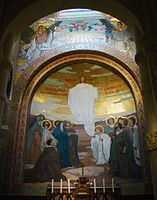
Ascension of Jesus
The Ascension of Jesus (anglicized from the Vulgate Latin: ascensio Iesu, lit. 'ascent of Jesus') is the Christian belief, reflected in the major Christian creeds and confessional statements, that Jesus ascended to Heaven after his resurrection, where he was exalted as Lord and Christ,[1][2] sitting at the right hand of God.[3]
The Gospels and other New Testament writings imply resurrection and exaltation as a single event.[4][5] The ascension is "more assumed than described," and only Luke and Acts contain direct accounts of it,[6] but with different chronologies.[note 1]
In Christian art, the ascending Jesus is often shown blessing an earthly group below him, signifying the entire Church.[9] The Feast of the Ascension is celebrated on the 40th day of Easter, always a Thursday;[3] some Orthodox traditions have a different calendar up to a month later than in the Western tradition. The Lutheran Churches and the Anglican Communion continue to observe the Feast of the Ascension.[10] Certain Nonconformist churches, such as the Plymouth Brethren, do not observe the feast.[11][12]
Although the ascension is an important article of faith in Christianity, only Luke and Acts contain direct accounts of it. In the shorter ending of Mark, in Matthew, and in John, it is only implied or alluded to.[6] The Gospels do not picture resurrection and ascension as clearly separated in time.[8] Other New Testament writings also imply resurrection and exaltation as a single event.[8]
Various epistles (Romans 8:34, Ephesians 1:19–20, Colossians 3:1, Philippians 2:9–11, 1 Timothy 3:16, and 1 Peter 3:21–22) refer to an ascension without specifying details, seeming, like Luke–Acts and John, to equate it with the post-resurrection "exaltation" of Jesus to the right hand of God.[13]
The ascension is detailed in both Luke and Acts, a pair of works ascribed to the same author, Luke the Evangelist:[14][7]
Luke and Acts appear to describe the same event but present quite different chronologies, the gospel placing it on the same day as the resurrection and Acts forty days afterwards;[16] various proposals have been put forward to resolve the contradiction, but none have been found satisfactory.[17] According to Dunn, the author of Acts separated the resurrection and ascension to put a limit on the number of resurrection appearances,[18] effectively excluding Paul's conversion experience from the bona fide resurrection appearances.[8] Zwiep argues that Jesus was originally believed to have been exalted with his ascension to heaven and seated at the right hand of God with his resurrection[5] until the late first century where he argues the exaltation had been separated from the resurrection, and moved to a final ascension into heaven after his appearances on earth.[5] Other scholars note that the biblical authors tended to conflate or compress different events and narrate them as one which was a literary theme seen in other ancient biographies to improve the narrative flow. Such scholars caution against a strictly chronological reading.[19][20]
John's Gospel has three references to ascension in Jesus' own words: "No one has ascended into heaven but he who descended from heaven, the Son of Man" (John 3:13); "What if you [the disciples] were to see the Son of Man ascending where he was before?" (John 6:62); and to Mary Magdalene after his resurrection, "Do not hold me, for I have not yet ascended to my Father..." (John 20:17).[7] In the first and second Jesus is claiming to be the apocalyptic "one like a Son of Man" of Daniel 7;[21] the last has mystified commentators – why should Mary be prohibited from touching the risen but not yet ascended Christ, while Thomas is later invited to do so?[22]
The longer ending of Mark describes an ascension, but is a later addition to the original version of that gospel.[23]









